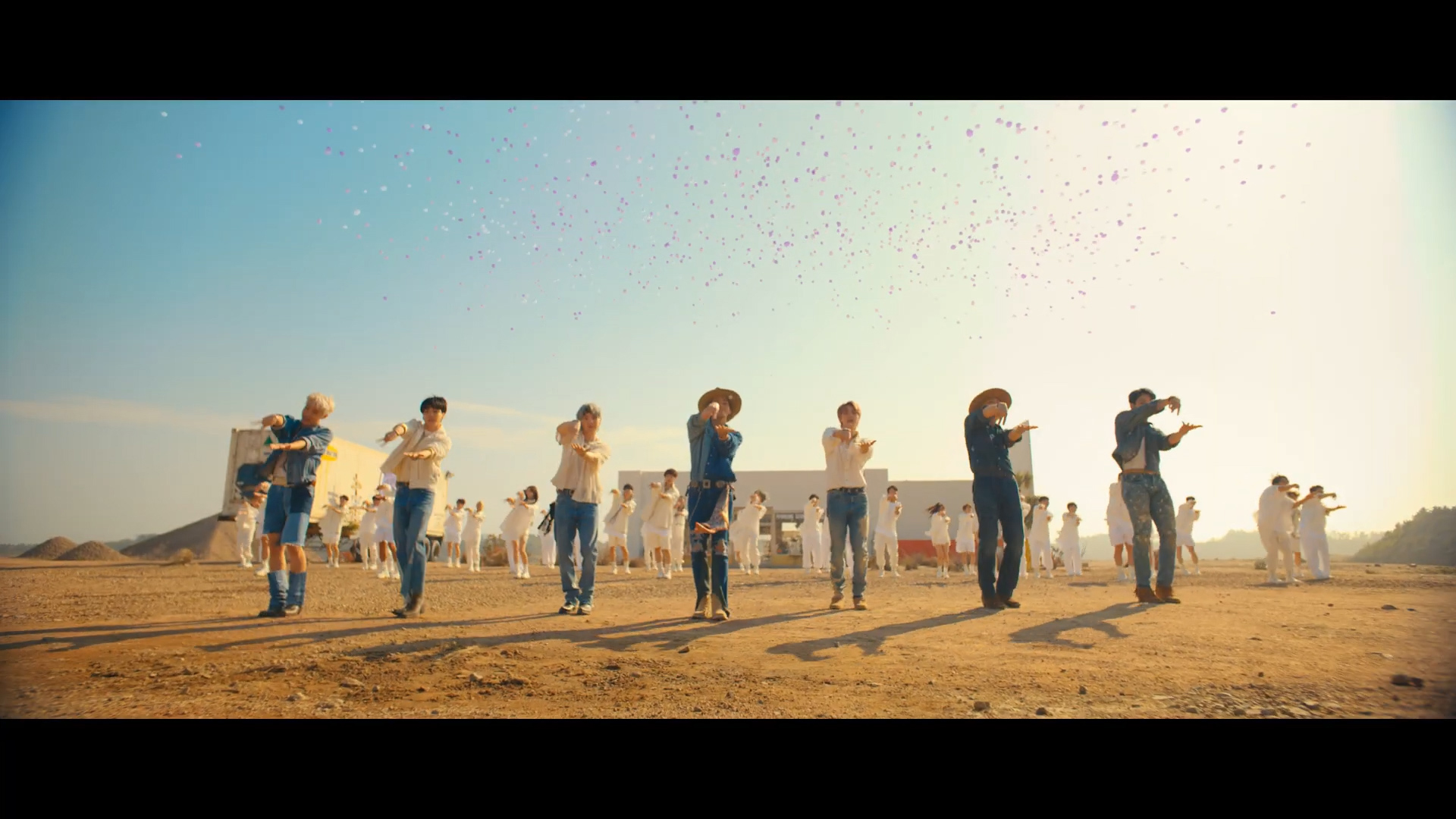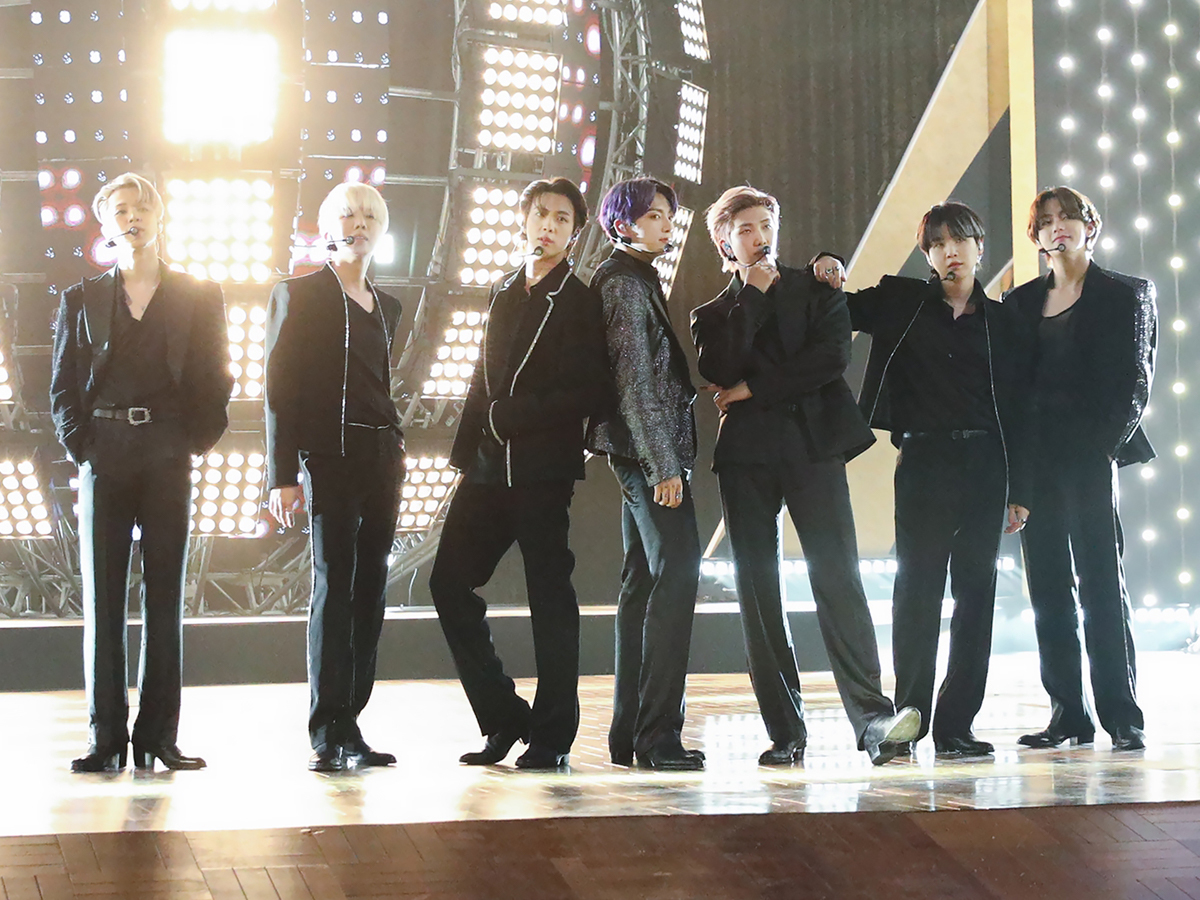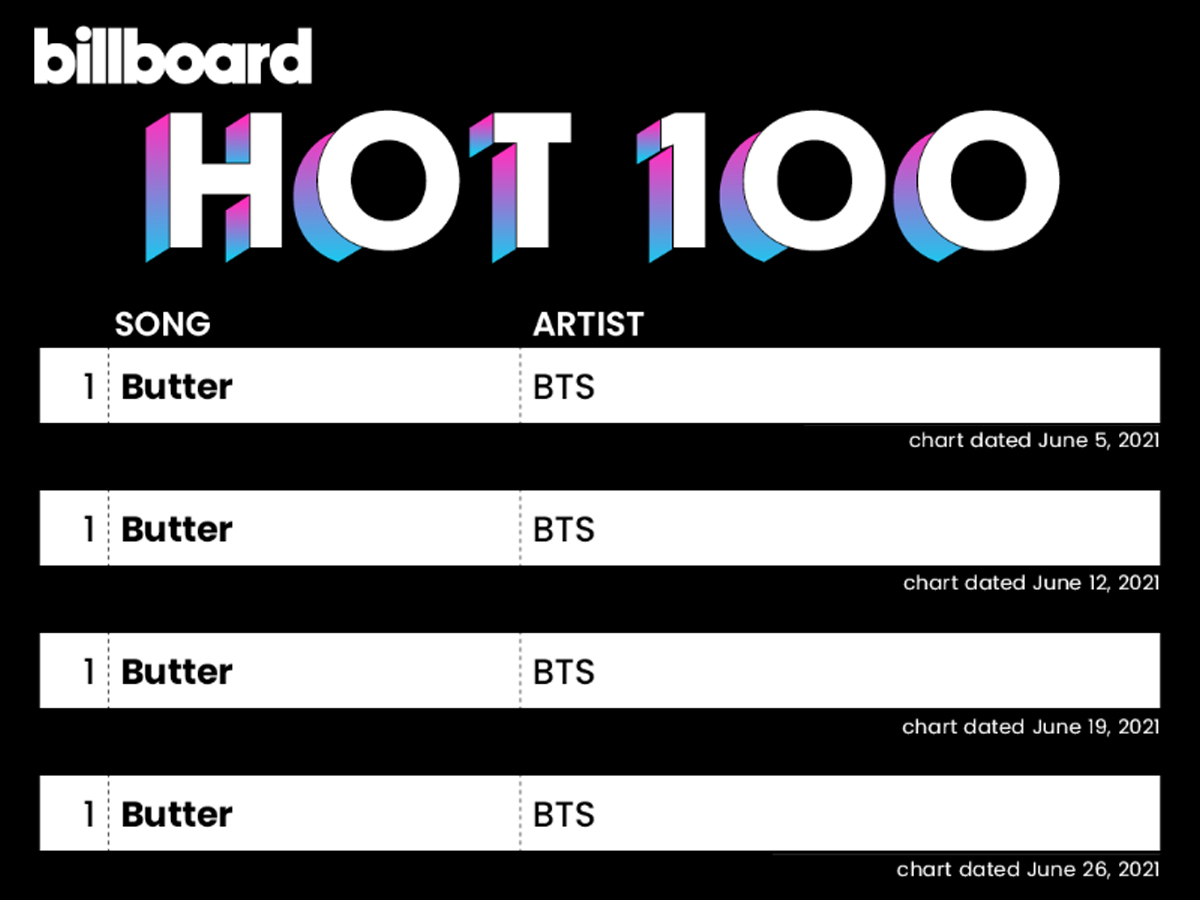
FEATURE
The Power of BTS’ Music
An overview of BTS’ year with “Dynamite”, “Butter”, and “Permission to Dance”
2021.07.21
On July 9, BTS released “Permission to Dance,” their third English single, following “Dynamite” and “Butter.” The three songs are similar in that they’re all light, exciting dance numbers. If you include the group’s Korean-language album BE and its lead single, “Life Goes On,” which came out between “Dynamite” and “Butter,” the songs carry a common message of hope for making it through the COVID pandemic together.
While “Butter” kicked things off with a feeling like a tangy soft drink, there’s no punch in the arm from “Permission to Dance.” The latest song is soft and wholesome from start to finish. In the past, BTS has bound their works together in groups of three as eras under a single theme, as with their early work—the “school trilogy”—and, later, the “Most Beautiful Moment in Life” trilogy. When looked at the way, “Permission” marks the end of an era: After “Dynamite” opened up with so much energy that “Butter” then gave shape to, this ending song is the finale of a look at overcoming daily life through the power of light, exciting music. It’s hard to think of a more suitable way to wrap up a trilogy that started with the intention of making music that can still make people smile despite the most widely anticipated world tour in history being dashed away.
All things considered, the virtue of “Permission to Dance” is in the comfort it imparts alongside the enjoyment. While “Butter” pumped up the energy with its strong bass, “Permission” is like a gentle, modest request that anyone can dance along to if they so desire. The funky fingerstyle bass draws you in and calls you to dance, while the delicate string arrangement adds a touch of sentimentality as it wraps its way around the melody. The choreography is simple to dance to and lowers the mental barrier to entry. BTS are capable of pulling off more complex and challenging choreography, of course, but considering the song’s message, it’s much more natural to keep it simple.
While “Butter” kicked things off with a feeling like a tangy soft drink, there’s no punch in the arm from “Permission to Dance.” The latest song is soft and wholesome from start to finish. In the past, BTS has bound their works together in groups of three as eras under a single theme, as with their early work—the “school trilogy”—and, later, the “Most Beautiful Moment in Life” trilogy. When looked at the way, “Permission” marks the end of an era: After “Dynamite” opened up with so much energy that “Butter” then gave shape to, this ending song is the finale of a look at overcoming daily life through the power of light, exciting music. It’s hard to think of a more suitable way to wrap up a trilogy that started with the intention of making music that can still make people smile despite the most widely anticipated world tour in history being dashed away.
All things considered, the virtue of “Permission to Dance” is in the comfort it imparts alongside the enjoyment. While “Butter” pumped up the energy with its strong bass, “Permission” is like a gentle, modest request that anyone can dance along to if they so desire. The funky fingerstyle bass draws you in and calls you to dance, while the delicate string arrangement adds a touch of sentimentality as it wraps its way around the melody. The choreography is simple to dance to and lowers the mental barrier to entry. BTS are capable of pulling off more complex and challenging choreography, of course, but considering the song’s message, it’s much more natural to keep it simple.
It’s important to note as well that the main composer is Ed Sheeran, an artist with a reputation for his sincere, laid-back melodies. Well-known these days for trendy pop songs like “Shape of You” and his recent release “Bad Habits,” Sheeran began as a folk singer-songwriter busking on the streets of England. Looking at songs like “Photograph," his acoustic pop hit, or “Love Yourself,” which he wrote for Justin Bieber, we can see he likes to use melodies centered around major thirds (do and mi) in the comfortable range of E major. These melodies, revolving around do and mi, sounds immediately familiar, allowing the songs to feel at once comfortable and unaffected, like you’ve heard it somewhere before. Most of the children’s songs we all heard as kids and grew up with have melodies in the major scale and are built around do and mi; “Permission” plays on this same idea. Unlike “Dynamite,” which opens on a high falsetto, and “Butter,” which begins with an impactful high note, “Permission” pins its root an octave lower at E2 and starts there, which is ever lower than middle C. As a tenor, Jung Kook can even sing in this key as though he were talking. That’s what makes it sound so gentle.
Here, the Canon chord progression—descending, one note at a time, as do, ti, la, so, fa, mi—is very familiar and comfortable to our ears. Because we’re all well acquainted with the standard do-re-mi scale it walks down, the song’s familiar enough that even those who hear the song for the first time can predict what’s coming next and again after that, and at the same time fills the listener with emotion. g.o.d’s “To Mother” and “One Candle” are prime examples of Korean idol pop songs that use the Canon chord progression directly or with minor alterations. The song “It’ll Be Good” by the experimental group Corporation, formed by Kim Hyun Chul and other singer-songwriters, is another medium-tempo song that, like “Permission,” serves to give gentle comfort to the listener who faces a tiring daily existence.
Surprisingly, though, the prechorus (“When the nights get colder … Just dream about that moment”) and postchorus (“We don’t need to worry”) aren’t a series of descending half-tones. Our ears become accustomed to the cascading notes of the previous parts, and so while we might expect these parts surrounding the chorus, which start with a minor chord, to do the same, the song never becomes emotional for more than two bars. They drop a mere half-tone from C-sharp minor to C on the word “worry,” as if furrowing their collective brow, but then they seem to quickly brush that worry aside with an A chord, unveiling a bright atmosphere with the words, “ ’Cause when we fall we know how to land.” After briefly losing heart, the song snaps right back and grabs hold of hope. And because it belies our expectations slightly, we feel all the more impressed with the song’s message: we know how to land, even if we fall.
The last repetition of the chorus after the bridge drops all instrumentation completely in favor of handclapping and a cappella harmony, like gospel. Right as listeners tune in to the beauty of all the people singing together as one voice, everyone in the music video—people who struggled at the front lines of the pandemic: services workers, teachers, senior citizens, and even teenagers and children—remove their masks to reveal their big smiles. No one is sure when the day will come, but the scene where they all sign along (“da na na na”) while dancing and signing the words for “fun,” “dance” and “peace” in International Sign shows the beautiful future waiting at the end of the pandemic that everyone is so eager to see.
At first glance, the lyrics are endlessly uplifting and innocuous. Similar to previous English-language releases, the song once again places the focus on feelings of happiness and enjoyment as previous English releases have, but by virtue of “Dynamite” having been such a hit, this time they have the freedom to toy around with being self-referential, as in the lyrics “da na na na” and “Well let me show ya / That we can keep the fire alive.” The difference between “Permission to Dance” and “Dynamite” or “Butter” is that the latest has the occasional image that overlaps with BTS’s narrative. Even among K-pop singers, BTS considers it particularly important to insert their own narratives into their music. Though their ability to achieve this may be limited when producing foreign-language songs, it may have also motivated the English-speaking songwriters to understand BTS more thoroughly in order to write good songs for the group. For example, lyrics such as “We don’t need to worry/ ’Cause when we fall we know how to land” can be read together with what SUGA said in an interview when they started down a path as unprecedentedly successful Korean singers in 2018—that “I’m afraid of falling but [if we’re together] I’m not afraid of landing.” There’s no way that’s a coincidence.
Here, the Canon chord progression—descending, one note at a time, as do, ti, la, so, fa, mi—is very familiar and comfortable to our ears. Because we’re all well acquainted with the standard do-re-mi scale it walks down, the song’s familiar enough that even those who hear the song for the first time can predict what’s coming next and again after that, and at the same time fills the listener with emotion. g.o.d’s “To Mother” and “One Candle” are prime examples of Korean idol pop songs that use the Canon chord progression directly or with minor alterations. The song “It’ll Be Good” by the experimental group Corporation, formed by Kim Hyun Chul and other singer-songwriters, is another medium-tempo song that, like “Permission,” serves to give gentle comfort to the listener who faces a tiring daily existence.
Surprisingly, though, the prechorus (“When the nights get colder … Just dream about that moment”) and postchorus (“We don’t need to worry”) aren’t a series of descending half-tones. Our ears become accustomed to the cascading notes of the previous parts, and so while we might expect these parts surrounding the chorus, which start with a minor chord, to do the same, the song never becomes emotional for more than two bars. They drop a mere half-tone from C-sharp minor to C on the word “worry,” as if furrowing their collective brow, but then they seem to quickly brush that worry aside with an A chord, unveiling a bright atmosphere with the words, “ ’Cause when we fall we know how to land.” After briefly losing heart, the song snaps right back and grabs hold of hope. And because it belies our expectations slightly, we feel all the more impressed with the song’s message: we know how to land, even if we fall.
The last repetition of the chorus after the bridge drops all instrumentation completely in favor of handclapping and a cappella harmony, like gospel. Right as listeners tune in to the beauty of all the people singing together as one voice, everyone in the music video—people who struggled at the front lines of the pandemic: services workers, teachers, senior citizens, and even teenagers and children—remove their masks to reveal their big smiles. No one is sure when the day will come, but the scene where they all sign along (“da na na na”) while dancing and signing the words for “fun,” “dance” and “peace” in International Sign shows the beautiful future waiting at the end of the pandemic that everyone is so eager to see.
At first glance, the lyrics are endlessly uplifting and innocuous. Similar to previous English-language releases, the song once again places the focus on feelings of happiness and enjoyment as previous English releases have, but by virtue of “Dynamite” having been such a hit, this time they have the freedom to toy around with being self-referential, as in the lyrics “da na na na” and “Well let me show ya / That we can keep the fire alive.” The difference between “Permission to Dance” and “Dynamite” or “Butter” is that the latest has the occasional image that overlaps with BTS’s narrative. Even among K-pop singers, BTS considers it particularly important to insert their own narratives into their music. Though their ability to achieve this may be limited when producing foreign-language songs, it may have also motivated the English-speaking songwriters to understand BTS more thoroughly in order to write good songs for the group. For example, lyrics such as “We don’t need to worry/ ’Cause when we fall we know how to land” can be read together with what SUGA said in an interview when they started down a path as unprecedentedly successful Korean singers in 2018—that “I’m afraid of falling but [if we’re together] I’m not afraid of landing.” There’s no way that’s a coincidence.
Conclusively speaking, the title and core theme of the song—“we don’t need permission to dance”— calls to mind the subtle gaze BTS has received as a group of K-pop idols with perfect choreography. People in the West never fail to point out the hair-raisingly perfect group dances and flowing movement when discussing K-pop—evidently, words of praise and awe. This overemphasis on accuracy can sometimes lead to unpleasant suspicions, however. While fans see such choreography, perfectly harmonized with the music, as pure pop entertainment, others call it “assembly-line training,” perhaps owing to the Yellow Peril, the racist belief rooted in a fear of Northeast Asians threatening to overthrow Western civilization. In science fiction, it’s commonly referred to as techno-orientalism: a prejudiced view of Asians, unlike Westerners, as emotionless, mechanical beings. Consider a recent case: In a master class for the Julliard School, Pinchas Zukerman, one of the most renowned violinists of the 20th century, was caught saying, “In Korea they don’t sing. It’s not in their DNA.” After provoking public indignation, Zukerman immediately apologized. Their prejudice against Asians leads them to see the repetitive practicing of K-pop artists and their dedication to their astonishing choreography and live performances as nothing more than an eccentric quirk. The constraints around these outsiders become all the more tight as the messages in BTS’s music deepen and the choreography becomes more elaborate. Their proclamation that they’ll dance without seeking anyone’s permission is therefore a welcome expression, but also one full of suggestion.
BTS released “Dynamite” as a bonus song while they were putting up with the difficulties they faced as outsiders. COVID-19 has since betrayed expectations and continued on longer than expected, and so both “Butter” and “Permission to Dance” were born out of a similar motivation to “Dynamite” one after the other. These three songs could be seen as part of a new catalog. Some might say these tracks aren’t like the BTS of the past, but consider that BTS already entered the Japanese market and created a separate, dedicated musical catalog with the releases of “FOR YOU,” “Crystal Snow,” “Lights” and “Film Out.” The apparently outsize influence of the US market seems to lead some people to see the group’s English releases as their main discography, but it’s not like the expansive Korean catalog BTS has built up over the past eight years is going anywhere. The meme making its rounds on the Internet about this being BTS’s version of the Trojan Horse captures everything perfectly. The image is that of BTS and ARMY making the American public open the doors under the pretext of exciting summer songs sung in English, then infiltrating them with the intricate, in-depth world of their Korean-language music. BTS was clearly able to greet a wider, all-encompassing public through the “Dynamite” trilogy. They’re now a beloved act for the majority of the public, not just in the US, but in Japan and India as well. It’s a good joke, but an astute insight, as well.
BTS released “Dynamite” as a bonus song while they were putting up with the difficulties they faced as outsiders. COVID-19 has since betrayed expectations and continued on longer than expected, and so both “Butter” and “Permission to Dance” were born out of a similar motivation to “Dynamite” one after the other. These three songs could be seen as part of a new catalog. Some might say these tracks aren’t like the BTS of the past, but consider that BTS already entered the Japanese market and created a separate, dedicated musical catalog with the releases of “FOR YOU,” “Crystal Snow,” “Lights” and “Film Out.” The apparently outsize influence of the US market seems to lead some people to see the group’s English releases as their main discography, but it’s not like the expansive Korean catalog BTS has built up over the past eight years is going anywhere. The meme making its rounds on the Internet about this being BTS’s version of the Trojan Horse captures everything perfectly. The image is that of BTS and ARMY making the American public open the doors under the pretext of exciting summer songs sung in English, then infiltrating them with the intricate, in-depth world of their Korean-language music. BTS was clearly able to greet a wider, all-encompassing public through the “Dynamite” trilogy. They’re now a beloved act for the majority of the public, not just in the US, but in Japan and India as well. It’s a good joke, but an astute insight, as well.
At a time when the entertainment industry has been put on hold, BTS has emerged from the pandemic an even more influential group worldwide. During this time, BTS has participated in #BlackLivesMatter and #StopAAPIHate, and also performed Coldplay’s “Fix You” live on MTV Unplugged. BTS’s Korean-language album BE, released late last year, aimed to come to terms with the COVID-19 era and contained tracks that were a study in how music could be a comfort to the listener in such a situation. Earlier on, we decided that “Dynamite,” “Butter” and “Permission to Dance” stand out as a catalog of their own, but if you take a step back and look at the group’s career as a whole, their musical vision itself has really not changed that much. They’re still trying to comfort the listener with music that keeps in step with the times. Some may question whether music really has such a power to begin with. Yet BTS’s journey has already provided an answer to that question through their music.
There’s a scene in the 2000 film Almost Famous where the group of main characters sings along to an Elton John song, just like is suggested in the lyrics to “Permission to Dance.” The characters sing along to “Tiny Dancer” as one, their happiness, beauty, and self-confidence overflowing, as if to say, Even if we’re in conflict, even if we hit a fork in the road of life and have to go our separate ways, we’ll always be just like now, singing our hearts out to a good song together. It’s a famous scene in the history of music-related film that comes up continuously. That kind of brief magic may be where music derives its power from. I guess what drives BTS to keep on pushing ahead tirelessly is their desire to spread that kind of magical, musical comfort to more and more people.
There’s a scene in the 2000 film Almost Famous where the group of main characters sings along to an Elton John song, just like is suggested in the lyrics to “Permission to Dance.” The characters sing along to “Tiny Dancer” as one, their happiness, beauty, and self-confidence overflowing, as if to say, Even if we’re in conflict, even if we hit a fork in the road of life and have to go our separate ways, we’ll always be just like now, singing our hearts out to a good song together. It’s a famous scene in the history of music-related film that comes up continuously. That kind of brief magic may be where music derives its power from. I guess what drives BTS to keep on pushing ahead tirelessly is their desire to spread that kind of magical, musical comfort to more and more people.
Article. Randy Suh(Music Writer)
Photo Credit. BIGHIT MUSIC
Copyright © Weverse Magazine. All rights reserved.
Unauthorized reproduction and distribution prohibited.
Unauthorized reproduction and distribution prohibited.
Read More

- Talking Music with “Butter”2021.05.26

- This is BTS-pop!2021.05.27

- What BTS achieved in the US2021.07.12
